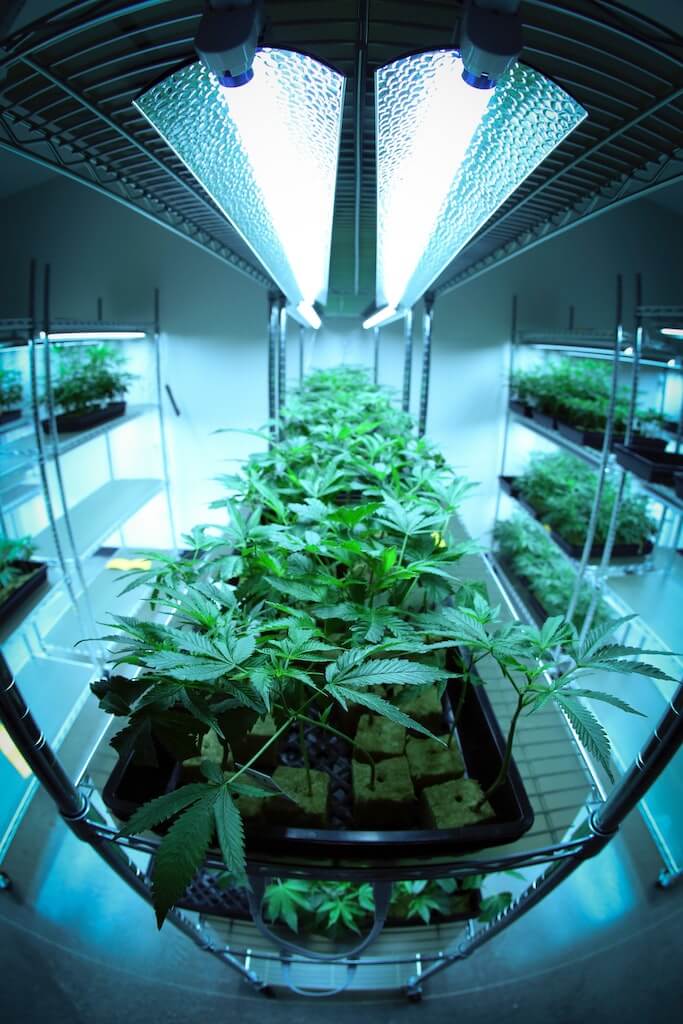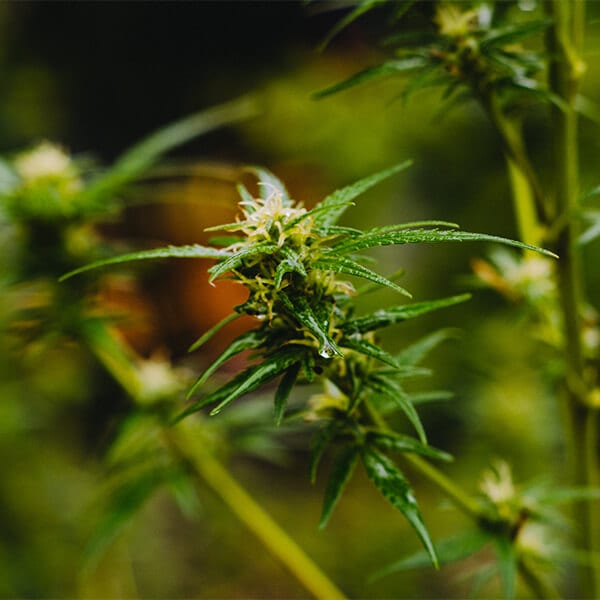Remove odors from growing cannabis, naturally and safely.
What Causes Grow Room Smells?
What Causes Grow Room Smells?
The strong odors produced by growing cannabis are often described as pungent, skunky, floral, fruity, or even “sewer-like.” Created by the plant’s essential oils (terpenes), odors are strongest when the flower is budding. Some grow room odors have been detected more than a mile from their source.
Cannabis odor is a complex mixture of chemicals. The “scent” comes from the terpenoids and terpenes that it contains. Terpenoids can be further classified into monterpenoids, sesquiterpenoids, diterpenoids, and triterpenoids. They can be acyclic, monocyclic, or polycyclic hydrocarbons that may have substitutions on them including alcohols, aldehydes, ethers, ketones, and esters. A mixture of general hydrocarbons also play a role in the odor.
“It is imperative for cannabis growers to understand the odors produced during cultivation and safely control them to maintain the quality of life for their neighbors and themselves,” says Dr. Laura Haupert, Director of Research & Development at OMI Industries, makers of Ecosorb plant-based odor elimination solutions.
The concentration and combination of odorous chemicals vary from grow facility to facility. Hundreds of different strains of cannabis can be grown, each with a unique scent profile. There are possibly over 200 individual compounds in cannabis, making the chemical makeup of odors complex.


Why Grow Room Odor Control is Important
Excessive grow room odors can be problematic for many reasons, requiring each facility to plan and build comprehensive odor control systems. Ignoring odors or using insufficient solutions can lead to damaged reputation or facility shutdowns.
Legal Penalties
Local municipalities often have unique guidelines for cannabis grow rooms. This includes the requirement of grow room odor control plans and, in some cases, zero odor emissions. Facilities that do not meet these strict codes face fines or risk removal of licenses or other legal action.
Neighbor Complaints
While many growers don’t mind the smell of cannabis plants, neighboring businesses and residents usually do. There is still a strong stigma around odors among the general population, even in states where growing, selling, and consuming is legal. Complaints from people working and living nearby can cause local governments to take notice and can incur fines or other penalties.
In 2014 alone, 30% of Denver’s odor complaints were from area cannabis growing operations. This number has potential to increase, and the patience of area citizens decrease, as more new facilities pop up.
Evidence of Improper Setup
If your grow room smells musty or has excessive odors, these can indicate the need for climate recalibration. Plants with ideal growing conditions should reduce the output of malodors. Poor ventilation, low air circulation, overly warm or humid conditions, and other issues can intensify grow room smells.
Note: this does not mean a properly set up grow room will have no odors. Odors will always be produced by growing cannabis plants. However, some environmental factors can cause malodor production to increase.
Grow Room Odor Equipment & Solutions
Typical cultivation facilities use a range of commercial grow room equipment to create and maintain an environment where cannabis can thrive. Much of this equipment is used to control elements that could damage the cultivation of strong plants — humidity, temperature, pests, light, microorganisms, and more. Any of these factors can negatively impact the chemical makeup of the plants, and their taste or smell.
This is why grow rooms typically attempt to keep all air flow contained within the room — in order to better control the environment from outside influences. Proper air control requires elaborate ventilation and circulation systems and is why carbon filters are heavily used in grow rooms to control internal odors.

Carbon Filters or Scrubbers
Activated carbon absorbs smells and other air impurities and works by the contaminated air stream passing through the filter. Carbon is porous, has a large surface area, which allows the carbon to absorb odorous chemicals.
Not all carbon filters work the same, use the same power source, or require the same amount of maintenance. Most carbon filters can extract odors, but do not remove all odors or all types of odors. For example, carbon filters work well on sulfur-containing compounds, but it is not as effective at treating nitrogen-based compounds. As a result, malodors can still be pumped out of grow rooms with escaping exhaust.
“Carbon filters absorb the substances until they reach their max capacity, at which point they do not absorb anything else. Carbon filters can’t catch all of the odors in a grow facility and therefore a solution for the air outside the grow facility is needed, “says Dr. Haupert.
Partnering carbon filters with other tactics is necessary to completely eliminate smells and prevent them from affecting neighboring businesses or residents.

Dehumidifiers & Air Conditioners
Controlling temperature and humidity is a fundamental step in reducing grow room odors. As plants absorb water and nutrients they create moisture (“transpiration”), adding to the humidity of the environment. A humid room can encourage black mold, powdery mildew, pests, and strong plant smells.
Grow room climates are especially temperamental, so growers must diligently monitor and maintain their room conditions. Dehumidifiers or air conditioners can regulate temperature and the ideal 40-50% humidity levels and help mitigate excessive smells.
This is why grow rooms typically attempt to keep all air flow contained within the room — in order to better control the environment from outside influences. Proper air control requires elaborate ventilation and circulation systems and is why carbon filters are heavily used in grow rooms to control internal odors.

Air Fresheners
Scented products are commonly used in homes and commercial spaces to cover up everyday odors. However, inside grow rooms, the use of perfumed sprays or gel products can negatively alter the chemical makeup of cannabis plants.
The synthetic chemical scents in air freshener products, even those designed for hydroponics, will attach to plants and can change its taste and smell. These effects can be irreversible, even after months of curing. This is why scented products like commercial air fresheners should never be used for grow room odor control.
“Any fragrance, natural or synthetic, is going to react with cannabis plants and cause them to change in taste and smell,” emphasizes Dr. Haupert.

Ozone Generators
Less commonly used, these systems create molecules of oxygen (O3 or “ozone”) to remove odors in the air and on surfaces. While powerful and effective, ozone is harmful to people, causing respiratory issues when inhaled even in small amounts.
Aside from producing toxic gas, ozone generators are much more expensive from other systems. And, like air fresheners, can damage cannabis plants. Ozone has been proven to inhibit the production of chlorophyll in plants — limiting growth or ultimately killing it. They are so harmful, the state of California has strongly warned against their use.
“Ozone is what is called a radical in chemistry,” explains Dr. Haupert. “It is highly reactive and will react with anything or everything it encounters, including people. That is why you cannot use ozone machines in a room with people or in a room that someone could walk into.”

Exhaust Fans + Plant-Based Odor Eliminators
Air circulation — with indoor fans, HVAC systems, and exhaust mechanisms — helps keep grow room temperatures low and humidity under control. Used CO2 is also pumped out of the grow space. All three combine to reduce plant smells.
The drawback, of course, is that odors are now moved from indoors to outside of your facility, making their way to adjacent neighborhoods and business parks. Plant-based odor removing products, like Ecosorb CNB 100, is an effective, safe solution to mitigate the odors from escaping grow room exhaust.
“The natural odor causing compounds found in cannabis are best dealt with using similar chemistry, that of plant-based solutions like Ecosorb,” says Dr. Haupert
Using a powerful blend of odor-eliminating plant oils, Ecosorb CNB 100 is scientifically developed to absorb and neutralize odor-causing molecules from cannabis terpenes. Because of its natural ingredients, Ecosorb CNB 100 produces no harmful VOCs or health side effects.
Innovative Vapor Phase Technology allows for easy and cost-effective installation of continuous, vaporized delivery around external exhaust systems without the need for added water. Thanks to its simple, safe design, Ecosorb equipment requires no permits to use.
Vaporized CNB 100 blends can be pumped from Ecosorb equipment and out through installed piping around exhaust vents at the top or sides of grow room facilities. As a secondary measure, perimeter systems are set up to neutralize remaining odors. Additional vaporization systems can be arranged around doorways or other places where air could escape.





